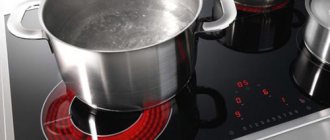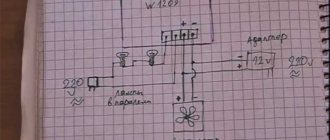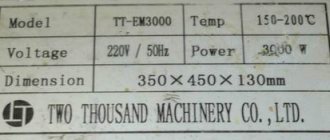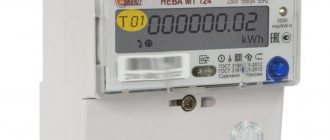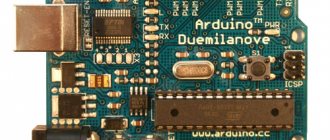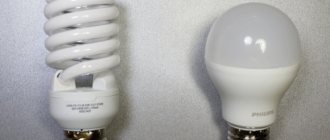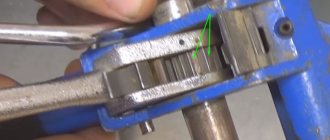An induction soldering station is the latest equipment, widely used both among professional craftsmen and electronics specialists, and among radio amateurs of various levels. Possessing a high heating rate, durability and safety, it is used for various types of installation and dismantling soldering work on microcircuits, when installing small and overheating-sensitive SMD radio components.
Device for soldering work with induction heating
Advantages of induction soldering irons
Soldering station for Arduino
The main advantages of such soldering equipment over analogues with ceramic heating elements are:
- High heating rate – the tip of the device warms up to operating temperature in less than 30 seconds;
- Reliability and durability – soldering equipment of this type is highly reliable; if used correctly, it has a service life of more than 10 years;
- The fineness of adjusting the heating of the tip - the presence of a large number of adjustments allows you to adjust the heating temperature of the tip with maximum accuracy, which is especially important when working with expensive SMD radio components that are sensitive to high temperatures;
- Safety - unlike analogues, such devices are less susceptible to breakdowns and breakdowns of the power cable to the device body;
- Convenience - the soldering irons of such devices have a convenient shape and small size, making them well suited for soldering small parts in hard-to-reach places.
Also, such soldering devices have a very high efficiency, since the ferromagnetic layer of the tip acts as a heating element, the soldering iron practically does not lose heat and completely uses it for various soldering jobs.
Induction soldering irons luxury or a step of evolution
Progress does not stand still and every day more and more new gadgets appear on the market, which it would seem should break the habit and force us to live in a new way. Probably those who came up with wonderful induction soldering irons had the same idea, but their price can surprise even the most advanced electronics engineer. And so about everything in order
Operating principle
Induction soldering iron
is a heating tool for surface mounting radio components on printed circuit boards, both household appliances and industrial installations. The difference from traditional soldering irons lies in the heating principle. In a conventional soldering iron there is a refractory metal with high resistance, this highest resistance prevents the passage of electric current through this conductor, as a result of which the conductor heats up and heat is transferred to the soldering iron tip.
The induction principle consists of heating due to an alternating magnetic field caused by high frequency currents, the magnetic field passes through the induction coil and causes the tip to heat up.
Replacement cartridges
The quick release of the tip is simply amazing, no more difficult than replacing a light bulb or plugging in a TV. One of the undeniable advantages of these soldering systems is the absence of temperature sensors. Instead, the tip itself protrudes, which is made of a special alloy and when heated, it loses its magnetic permeability (not magnetite) and heating stops as soon as a deviation from this temperature occurs, magnetic properties are restored and heating resumes. Thus, heating occurs without overheating, and the heat is released exactly as much as the contacts need, which eliminates the problem of overheated contacts and cracked SMD ceramics.
The soldering iron handle is very light and balanced, which makes soldering a pleasure, and the famous “Wave” tip works wonders when soldering microcircuits
Prices
Now the most interesting thing about this instrument is the Price. Maybe I'm a stingy miser, but giving 60 tr. for a soldering iron that does not overheat the contacts and lies comfortably in the hand, it is very, very expensive, I would even say oh so expensive. When I heard this price at an international exhibition, I wanted to spit in the face of the person who showed me and talked about this instrument for 15 minutes. Probably, washing machine repair technicians have not yet matured enough to use such a tool, and spending $1,000 on a soldering iron will soon become commonplace, but I’d rather order a Chinese one for a good 1,000 rubles and be happy and spare the cost of solder and flux.
Video
Design and principle of operation
Soldering station - operating principle and types
The induction soldering station consists of the following elements:
- Electronic unit with step-down transformer and generator;
- A soldering iron with an inductor heater connected to the block using a long flexible cable and a special connector.
The working part of such equipment is a soldering iron with an inductor installed inside it - a coil of copper wire wound around a socket into which the shank of a replaceable tip with ferromagnetic coating is inserted.
The design of the heating element of an induction station for soldering
The process of heating the tip with an inductor occurs as follows:
- The generator supplies a high-frequency current with a voltage of 36 Volts through the power cable to the inductor coil;
- The current passing through the turns of the inductor generates an alternating magnetic field, the lines of force of which intersect the tip shank located inside the inductor with ferromagnetic coating on the surface;
- The magnetic field, when interacting with the ferromagnetic coating on the tip shank, leads to its magnetization reversal and the formation of eddy currents. This process is accompanied by the release of a large amount of heat and very rapid heating of the shank, the trace and the entire tip to a high temperature.
The current (its frequency, and therefore the temperature of the tip) is adjusted using adjusting encoders on the electronic unit.
Advantages and disadvantages
The main advantages of this type of device compared to similar equipment with ceramic heating elements are:
- High heating rate. The working part of the unit heats up to the required temperature in less than 30 seconds.
- Reliability and durability. This class of equipment, when used correctly, has a service life of more than 10 years.
- Ability to adjust heating settings. The soldering iron has a large number of adjustments, allowing you to set the heating temperature of the tip with high accuracy.
- High temperature SMD radio components. They are especially important for sensitive operating mode settings.
- Safety. Unlike similar soldering irons, such devices are less prone to failure and do not damage the power cord connected to the device body.
- Convenience. The soldering iron has a convenient shape and small size, which makes it ideal for soldering small parts, especially where they are difficult to reach.
- Moreover, such a soldering device has very high efficiency, since the ferromagnetic layer of the tip is used as a heating element. The device does not actually lose heat.
- Soldering iron design
The disadvantages of this type of soldering devices include:
- It is necessary to purchase replacement tips separately if you need to change the soldering mode.
- The cost relative to other soldering irons is quite high.
Heating control principle
DIY soldering station
In induction soldering stations, 2 methods are used to control the temperature to which the soldering iron tip is heated:
- Using a temperature sensor built into the tip, a thermocouple placed in the tip sends signals to the electronic unit, which, based on the received data and established adjustments, heats the device tip to a certain temperature;
- Using replaceable tips (cartridges) - most modern models of such soldering devices come with several replaceable tips that have a ferromagnetic coating that loses its magnetic properties at a certain temperature.
On a note. The technology of using replaceable cartridge nozzles with ferromagnetic coating, which ensures heating of the tip to a certain temperature, is a development and is called “Smart heating”, or “Smart heat”.
Replaceable nozzles (cartridges) with ferromagnetic coating
The first method is found in inexpensive semi-professional models. Its main advantages are relative cheapness and ease of adjustment. The second technical solution is used in more expensive, high-quality and reliable models of professional soldering stations.
Induction soldering station (soldering iron) QUICK3202 ESD + easy modification
In my opinion, the best budget induction soldering station that is really worth the money. The station has been in operation for a long time, so the review is for a “time-tested product.” First, a short excursion into the differences and advantages of induction heating technology for a soldering iron tip. In addition, today there are 2 fundamentally different algorithms for controlling the temperature of the tip - thermocouple control + PWM regulation and control through the Curie point (patented technology used in Metcal stations). The pros and cons of these technologies from the point of view of a marketer can be described on a couple of pages, turning them to their advantage light this or that, I will try to highlight the main theses. Classic
(thermocouple + PWM) - the most important plus is versatility.
I can set absolutely any tip temperature and it will be maintained. And for any sting. The downside is that the temperature stability is slightly worse (which will still be an order of magnitude better than classic soldering irons with a conventional heating element). Metcal
(Curie point) - the main advantage is the highest thermal stability and compactness (induction soldering irons from Metcal are the smallest).
The main disadvantage is that each tip is adjusted exclusively to its own temperature. It is impossible to somehow force a tip at T=215"C to work at T=230"C. Therefore, you will need to buy each type of tip for each planned operating temperature. A separate point should be considered the cost of ownership
. Both the station and the stings from Metkal can force you to sell your last panties. An original new tip costs, if my memory serves me right, from 50 euros apiece. The station is also not cheap. Therefore, basically “Metkalovites” buy a non-working used unit (station) on eBay, repair it, convert it to our network voltage, and buy sharpened used tips. on the same ebay, with an unknown remaining resource. For about 15 years now, the optimal solution has been stations from the Chinese manufacturer QUICK. They make a good, high-quality and reliable segment (I haven’t tested the rest of their products, so I can’t say for everything, but the list below went through my hands and I can advise). During this time, I used for a long time: Soldering irons - Quick 202D, Quick 3202ESD Soldering hair dryers Quick 957DW, Quick 861dw Soldering stations (hair dryer + soldering iron) Quick 713ESD, Quick 712ESD.
Today I will show the “inner” of the Quick 3202ESD, its minor modification and differences from the others from the list above (as well as the differences between those sold, since it turned out that the Chinese “economy” does not sleep).
*I’ve been using the station for over a year now, and I planned to do a review right away... but I never got around to it.
Therefore, the photos will be of the new station, although in fact it has been in use for a very long time (with modifications, which is important) in a full-fledged operating mode. *Link to a similar lot, mine is no longer there, and good, more on that below
Packaging
: The station is supplied in a high-quality cardboard box, in which each component is placed in an individual compartment of a polyethylene foam tray. The top is also covered with the second half of the cradle (not shown in the photo)
An attentive eye can already see a certain difference, which thoroughly upset me, however, this was reflected in the price of the lot (I bought mine much cheaper - about $130). Namely, a different model of soldering iron. I will describe this in detail below. So, the entire package is presented in this photo - a station, a soldering iron, a stand, a viscose sponge for cleaning the tip and a rubber potholder for changing hot tips.
Fan-front and other portraits xD
I'll hide the dismemberment under the spoiler. Not because it’s 18+, but just a lot of photos so as not to break the narrative part of the review
Additional Information
Now about the sad stuff. Kwik soldering irons have 2 different ways of attaching tips, and, accordingly, 2 approaches to replacing them. 1 - classic (Lukeevksy) “under the nut”, it is implemented in many of their models of inexpensive soldering irons and in the Quick 712 station. Name of the handle (soldering iron) Quick901a
2 - quick-detachable - the tip of the “cartridge” is simply inserted “until it clicks”, and when changing, it is simply “pulled off”. Used in the “premium class” - the Quick 713 combine, my first Quick 3202 (yes, this is my second 3202, the first one was used 8 years ago and was sold for personal reasons) and later in several more models. Name of the handle (soldering iron) Quick901b and Quick901c (they differ in the maximum (peak) power of the induction coil)
Obviously, I was expecting a quick-release option, because... I’ve been working with it for a long time and, in principle, the “nut” method is inconvenient and time consuming, but that’s what I got – “under the nut”. In addition, I had already purchased a dozen working and spare tips specifically for “quick release”... Fortunately, I had a spare Quick901c soldering iron, which I bought a long time ago for the 713th Quick and which I never needed. But even here a “bummer” awaited me: 901a differs from b and c not only in the tips, but also in the electronics. 901a is just an “adapter” with a rest sensor, i.e. There are no electronic components inside the soldering iron, only the sensor and wires to the thermocouple, coil and ground wire. And the 901b/c contains a full-fledged printed circuit board with a thermocouple amplifier (with cold junction compensation) and a bus driver (i.e., data from the sensor is transmitted to the station in an interference-free manner).
901a
901c
First of all, I tried to directly replace the soldering irons in the hope that the station would determine the type of soldering iron and “pick up” the new communication protocol... Unfortunately, this was not possible. Further searches led to the understanding that there really are 2 revisions of 3202 stations that differ in soldering irons and... firmware of the main processor of the front panel. I was able to find the pinout of the service connector and was able to remove the firmware of my station, but nowhere could I find the firmware of the station for the 901b/c soldering iron. For Muska's readers, I will leave a link to the archive:
https://drive.google.com/file/d/1T7s2L-3ShsSVSZbcl80QALKFo40ox_Xv/view?usp=sharing There you will find all the necessary information for backing up a dump from your native processor and uploading alternative firmware. ATTENTION! I did not check the programming of the controller of this station, I just removed my backup and do not guarantee its functionality. I also don’t know if my backup will work on your station and I have no idea if your MK is locked from reading/firmware! You do all manipulations at your own risk!
After failure with a full replacement, I only replaced the attachment point for the tips themselves. The induction emitter and thermocouple assembly is the same for both versions, so I only needed to replace the tip fixation - this is a small part that simply screws onto the base of the handle. Yes, this did not add to my “digital temperature” and the stability of the readings, but, as practice has shown, this is not very critical in operation (but still noticeable, it is worth recognizing this fact; soldering iron “a” is more inertial than with “brains”).
Yes, I didn’t say anything about the modes and performance characteristics of the station... I don’t think they can say anything to a person who has not worked with induction... the fact is that a 60W induction soldering iron is completely different from a 60W ceramic heater. Where 60W ceramics will “freeze”, 60W induction will barely notice the resistance... You need to work to compare the difference. The only thing I would like to focus on is that the 3202, like the 713 (unlike the 712), has a 3-cell memory mode, which is very convenient. Access to presets - click on the “star” in a circle, i.e. each subsequent press activates the next preset, looping them. Plus, the station remembers the last used parameters before turning off. The temperature setting range is up to 450 °C (and believe me, you will never use T even 400, since induction allows you to comfortably work at lower temperatures than the “classic”).
A few words about the difference with the Quick 202D, which many consider to be a kind of icon, and for which the price tag, IMHO, remains very high precisely because of demand. Yes, the 202 really was a breakthrough for its time, and yes, those who switched to the 202 after the “Lukeya” will idolize it and are unlikely to buy anything else... but in essence it loses to the 3202 in all respects. The tips are much more expensive, the external thermocouple, contrary to marketing slogans, works worse than in 3202, the handle itself is less ergonomic, the station requires temperature calibration after each tip change. Otherwise they are similar in functionality.
Now for a small improvement.
The only drawback of the 3202 (well, apart from the “slipped” version with stings under the nut) is the loud fan. To cool the inverter, a small, noisy cooler is used, which the Chinese genius turned on for constant operation at full power. Yes, it has no such thing as adjusting speed or turning it on when necessary. In a station for 100+ bucks, sparing 2 MK legs (or several small SMD parts) to control the temperature and control the cooler is extremely unreasonable. As a result, the hum of the fan generates in my head a clear decision to drive a nail into it after a couple of weeks of operation... At first, I decided to analyze the heating of the station - maybe it really gets so hot that a constant intensive mode is necessary?, but having covered the modules with thermocouples, I saw that nothing ever heats up above 60"C in my operating mode (and the station sometimes works for 10 hours without turning off). Therefore, the original idea with reobass (adjusting the speed of revolutions) was replaced by a scheme of periodic switching on “as needed”. For this purpose, we purchased a mechanical thermal relay at 60°C with normally open contacts, through which the cooler is powered, and an emergency thermal switch at 75°C with normally closed contacts, through which mains power is supplied to the device. During the year of operation at the station, not a single relay worked - neither to turn on the fan, nor to turn off the station in an emergency. Silence didn't cost me much at all
Conclusions. Induction coils cannot compete in the price range of cheap Lukeys or T12 for 5-20 bucks; I myself keep a cheap T12 as my second soldering iron (for travel and just as a backup soldering iron), but I use it only in extreme cases, because... In terms of comfort, induction is orders of magnitude better. And I hesitated for a long time to review it precisely for this reason. But seeing how people buy and praise all sorts of “designer” soldering irons (a stone in the direction of the TS100 and similar perversions), I finally decided, because... at the same (i.e. average) price range, working with an induction soldering iron is the “high” that every soldering iron should experience ^_^ I hope the review was useful.
*As usual, I apologize for possible grammatical and stylistic errors, I have been living in a different language environment for a long time... if there is anything wrong, write me in a personal message, I will correct it.
Choosing the right model
The main criteria for choosing such equipment for soldering are the following:
- Power – the most convenient and practical models of soldering stations are those with adjustable power in the range from 5 to 60 W;
- Frequency of current in the inductor - for radio amateurs and semi-professionals, a device with a current frequency of 400 to 700 KHz is sufficient. Professionals and craftsmen use models with values of this characteristic up to 13.5 MHz;
- Type of heating control - most of the modern equipment of this type is produced with regulation of the heating temperature of the tip using the “Smart heat” technology;
- Number of independent channels – in order to be able to connect, in addition to a soldering iron, thermal tweezers, the device must be equipped with 2 independent channels;
- Dimensions and weight – for convenient operation and carrying, the device should be small in size and weigh no more than 1 kg;
- Also, when choosing, take into account the possibility of post-warranty repair of the device, the availability of additional components that make the soldering process more convenient.
Quick 203H induction soldering iron from China (Tests, comparison with conventional soldering irons)
Hello! I’ll immediately explain the price: the seller raised the price, apparently after my angry review. The station came to me without a soldering iron! I do not recommend buying from this seller at any price. But there will be a review! The cheapest offer I've found on Ali now
aliexpress.com/item/QUICK-203H-203H-high-frequency-digital-soldering-station-iron-90W-Intelligent-Lead-free-high-frequency-welding/32566448156.html,searchweb201602_3_505_506_503_504_10020_502_10001_ 10002_10017_10005_10006_10003_10021_10012_10004_10022_10007_10018_10019,searchweb201603_1&btsid=b5b98ff3-a335- 4068-8ae7-e69c67e5f90f There are options on Tao, but there you need to know the tricks of combining parcels and working as intermediaries. I'm not hanging around there yet.
In this review, I will try to introduce you to an induction soldering iron from China. To begin with, let me give a little explanation regarding the principles of operation of this device!
In induction soldering irons, the tip is heated by supplying energy to it in the form of a high-frequency electromagnetic field created by an inductor coil.
Inside the tip there is a ferromagnetic core, which is heated due to hysteresis losses and, to a lesser extent, due to eddy currents. In such soldering irons, only the tip is heated, which makes the soldering iron extremely light and miniature. Thermal stabilization of such soldering irons can be carried out either in the traditional way (using a thermocouple or thermistor in contact with the tip), or by selecting a ferromagnetic core material with a Curie temperature equal to the required tip temperature. When this temperature is reached, the core loses its ferromagnetic properties and the energy supply due to magnetization reversal stops. More details here:electrik.info/main/praktika/871-indukcionnaye-payalnye-stancii.html
This product of the Chinese industry is an analogue of the branded soldering iron Quick 203. Here they (originals www.quick-global.ru/1-lead-free-soldering-2b.html) are sold in the Russian Federation (office representative Qucik technica-m.ru/katalog .html/fol_242).
The principle of operation is as follows: a high-frequency generator causes the metal tip to heat up to a predetermined temperature, which is regulated using a thermocouple pressed to the tip from the inside. Advantages of this thermal stabilization option: +Low heat capacity (inertness) of the heating device. + Absence of an air gap between the heater and the tip (the tip is the heater) + Relatively high speed of response to changes in the temperature of the tip due to touching parts, a board, etc. +High heating rate (well, this follows from the first point) Cons: -Complexity of the circuit -Price (compared to conventional soldering irons) -You need good tips. With the default it's just sad. -Possible effect of high frequency on the body (but not really proven, I have not conducted any research on this particular thing and have not seen it on the Internet) -Bulky (compared to conventional soldering irons)
Characteristics: Temperature range 100℃-600℃ Temperature stability ±2℃ Input voltage/frequency 220V 50Hz/60Hz Output voltage/frequency 24V AC 400K Hz (found measurements on the Internet ~280 KHz) Max. power 90W Microprocessor control Heating High power current Sleep mode Automatic Temperature lock Password Weight (without power cord) Approximately 2.8 kg
Photos of the insides:
So my delivery kit: Let me remind you that there is no soldering iron in the kit, but there are some 4 screws (legs) that have nowhere to screw. Front panel: Box weight: Device weight with kit:
Working with a soldering iron: Adjusting the temperature using keys ▲ and ▼. When turned on, the station turns on at the temperature set when turned off. Go to the settings menu by holding * for 2 seconds. 0- 1-Maximum temperature that can be set with arrows (max. 600!!). 2-Minimum temperature (100-150-200C) 3-Temperature of the soldering iron in sleep mode (100-300C) 4-Time in minutes to switch to sleep mode (when the soldering iron does not move) 5-Time in minutes before the soldering station turns off (time in point 4 + time in mode 5) 6-Lock mode 7- 8-not available 9-password for access to settings mode (to disable, set the password to 000) Enter calibration mode: hold down * and press ▲ without releasing. Set the temperature on the tip (real). Testing: I took 2 boards (from a UPS and a computer motherboard (noPb)) to solder various components with 4 soldering irons: -Quick 203h -CT-96 -Usb 8w 5V -EPSN-40/220
Please watch the video for details. I'll get straight to the results!
●Quick 203h solders at 370C worse than ST-96, but better than the other 3 tested. Very long heating of massive parts. Without problems, you can only work with SMD, small conductors, and boards with lead-containing solders. (or dilute the solder). ●ST-96 copes poorly with all tasks (including desoldering transistors of the processor power supply circuits and capacitors from the same place). If you turn it up to maximum. The question is how long the tip and the heater will last. ●Usb 8w 5V takes only SMD components. I'm not capable of anything else. I didn’t unsolder anything from the UPS board! Well, maybe you can solder some wires that aren’t too thick somewhere in a children’s toy. Toy soldering iron. ●EPSN-40/220 cannot cope with soldering capacitors from motherboards (it would be worth having 60 W for this). Otherwise, an excellent soldering iron if used with lead-containing solders. I unsoldered the UPS board, which was required. If you buy it, buy it with a wooden handle. Very reliable thing.
CONCLUSIONS:
You shouldn’t buy from the sales I mentioned above (via the link “
go to the store ○With the default sting it shows very disastrous results for this price. ○If you have something like the ST-96, you probably shouldn’t bother with it. The overpayment does not correspond to the additional benefits. ○You definitely need to buy additional tips (original Hakko or Quick), and this increases the already considerable price.
Here I bought an additional soldering iron: ebay.com/itm/141811643244 (eBay item number: 141811643244)
Soldering iron photo
Is it possible to make an induction soldering station with your own hands?
The wide variety of models of such equipment makes its independent production practically impractical and costly; it is easier to buy a simple Chinese device, which at a low cost will have a fairly long service life and good soldering quality.
Therefore, you can make an induction soldering iron with your own hands solely out of scientific interest, having studied the internal structure of such a device and the physical phenomena occurring in it in more detail and clearly.
Taking measurements using an induction soldering station
Monitoring soldering temperature using a thermocouple and multimeter
When soldering various small radio components, in accordance with the requirements of various regulatory documents, recommendations of manufacturers of electronic components, safety precautions, the temperature of the tip when it touches the working surface should not be higher than 2700C. When working with the described soldering equipment, this indicator is set using adjusting encoders on the electronic unit of the device. Check the correctness of this setting by touching the tip of the device with the tip of a thermocouple connected to a multimeter.
Design
The induction soldering station consists of the following components:
- electronic unit with step-down transformer and generator
- a heating sensor that connects to the device using a long flexible cable and a special connector.
- The working part of such a device is a tip, in which copper wire is wound around a socket where the shank is inserted.
You might be interested in this: Shredder attachment for grinder
Device structure
Additional equipment
In some models of this soldering equipment, the extended package includes the following tools and accessories:
- Thermal tweezers;
- Soldering iron holder;
- A set of replaceable nozzles for different temperatures.
Also, some expensive soldering stations have a small display on the electronic unit that displays the temperature of the device tip.
Thus, a soldering station with an inductor heater is equipment that has many advantages. This makes it in demand and popular among both specialists and ordinary radio amateurs.
